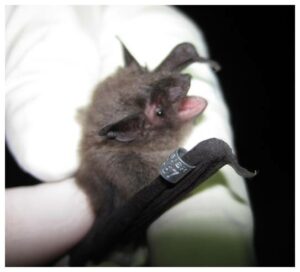Indiana Bat
Scientific Name: Myotis sodalis
Description.
Indiana bats are relatively small, only weighing between 5 and 11 grams with a wingspan of 240 to 267 mm. While they look similar to other members of Myotis, their distinctly keeled calcar, a projection of the foot, distinguishes them and also adds stability to their wings. Their fur is also softer than the similar species, the little brown bat. While male and female Indiana bats look similar, there is slight sexual dimorphism with females being slightly larger than males.
Distribution.
Indiana bats are only found in North America, ranging from northern Arkansas, Iowa and Missouri to western Virginia and North Carolina, and as far north as Vermont. These bats roost in the southern part of their range during the summer and hibernate in the northern part of their range during the winter. They hibernate in limestone caves and sometimes under the bark of dead trees during the winter. Summer roosting occurs under bridges, under the bark of large trees and occasionally in buildings.
Ecology and Behavior.
Indiana bats are more social than most bat species with males and females hibernating together and females forming maternity colonies. However, social hierarchies have never been recorded with these bats. They migrate between their summer roosting sites and their winter hibernation sites.
Food and Feeding.
The Indiana bat’s diet is mostly made of five different types of insects: butterflies and moths, bees and wasps, beetles, flies, and caddisflies. A female’s diet is also based on whether she is pregnant, lactating, or neither. For example, a lactating female eats more beetles and caddisflies than a non-lactating female. Their diet will also depend on their geographic location.
Reproduction and Development.
Mating occurs right before hibernation in the fall. Indiana bats are also polygynous, meaning one male will mate with multiple females. Females store sperm during hibernation with fertilization occurring in spring, right after hibernation. Typically a female will only give birth to one pup per year.
Status.
Indiana bats were the first bat species to be listed as “endangered” in 1967 under the new Endangered Species Act with their main threat being habitat loss. The vast majority of individuals gather in large groups for hibernation, but use only a small number of caves, making them extremely vulnerable during hibernation. The EPA has listed these specific caves as protected habitats in an effort to protect this species and they continue to closely monitor their populations. The Indiana bat is one of the species affected by White-nose Syndrome.
- Click here to see where you can find the Indiana Bat in NC!

